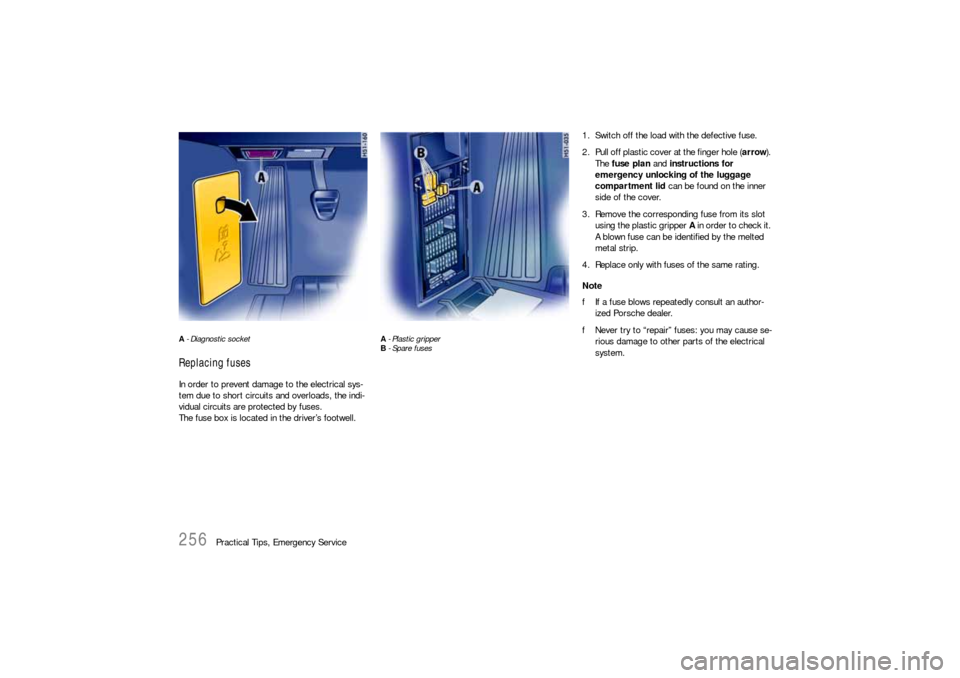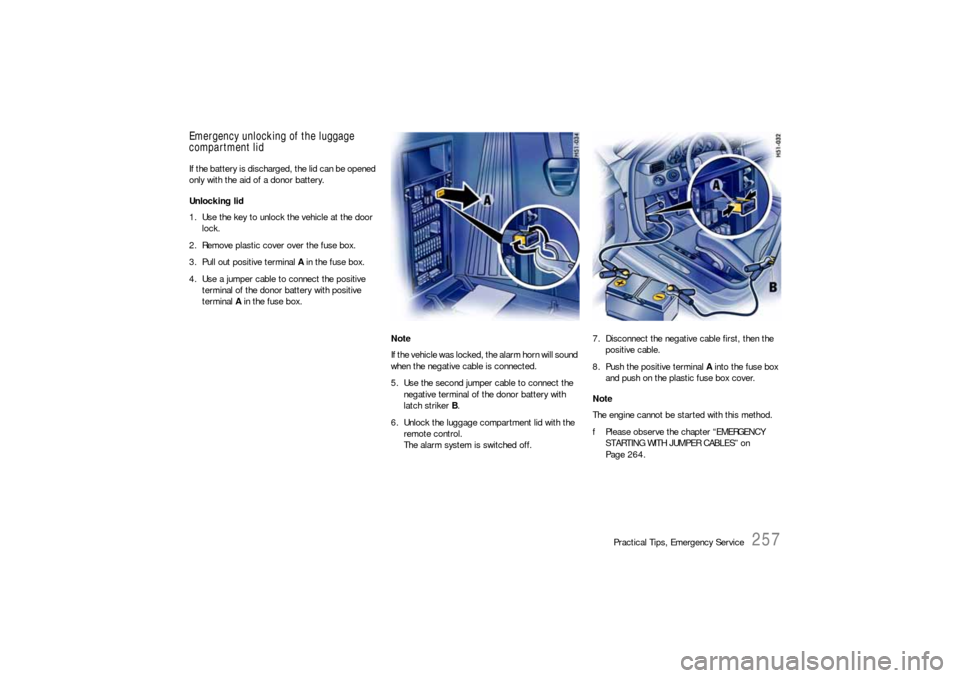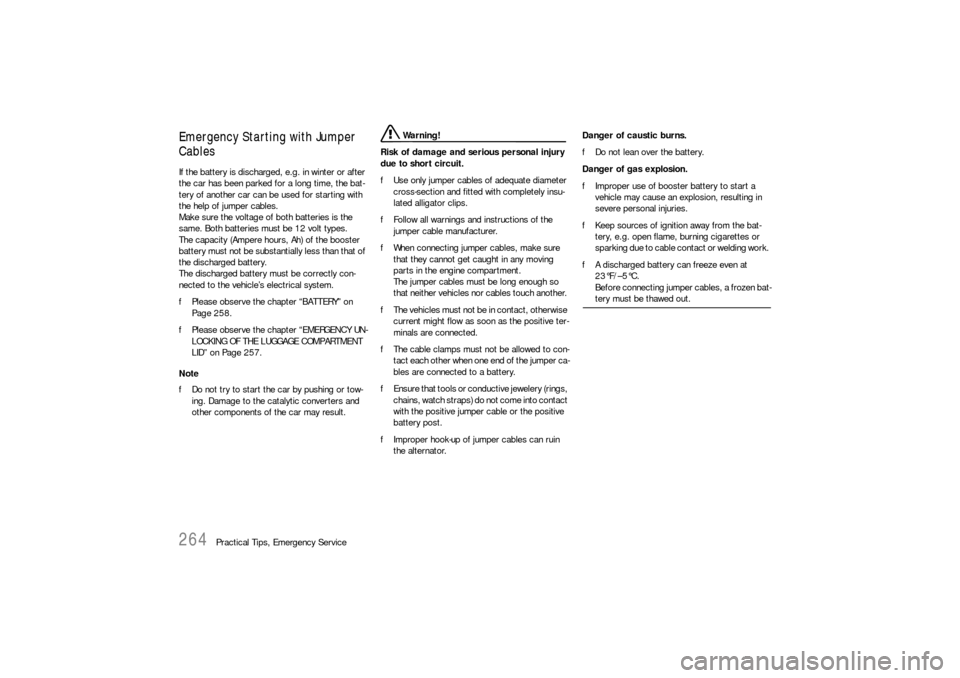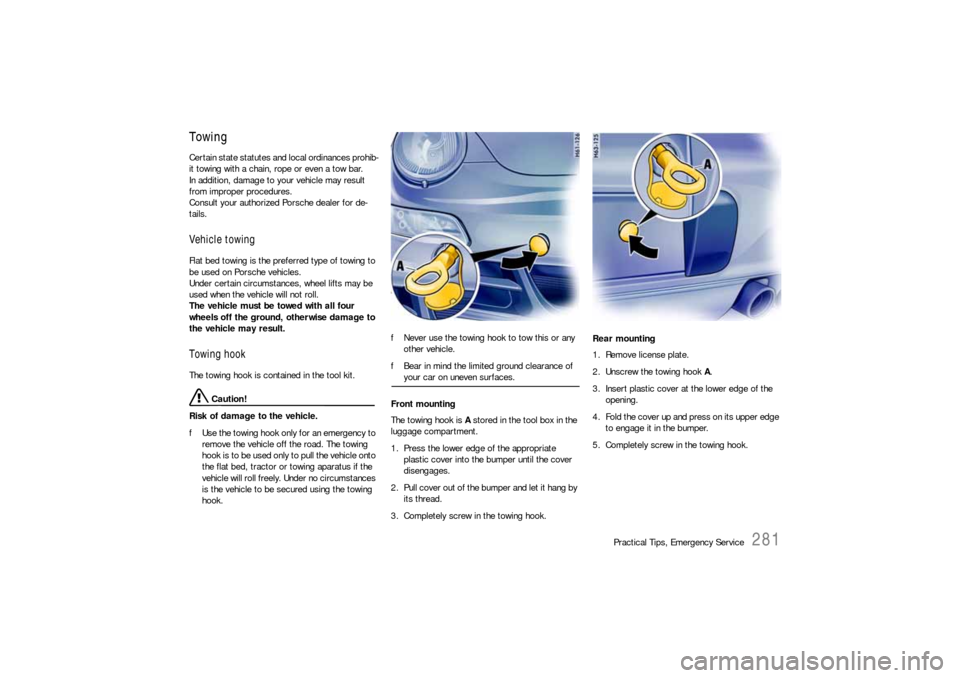fuse PORSCHE 911 CARRERA 2006 5.G Owner's Manual
[x] Cancel search | Manufacturer: PORSCHE, Model Year: 2006, Model line: 911 CARRERA, Model: PORSCHE 911 CARRERA 2006 5.GPages: 308, PDF Size: 3.69 MB
Page 254 of 308

254
Practical Tips, Emergency Service
Long wheel bolt
X - bolt length approx. 50 mm
Arrows - marksWheel bolt identifying features
The long wheel bolts are identified on the face
surface of the bolt head with GT or in red, or the
moveable spherical cap ring is galvanised in red.
The long wheel bolts must only be used together
with 5 mm spacers fitted.
The short wheel bolts are not marked in colour.
The short wheel bolts must only be used without
5 mm spacers fitted.
Tightening torque for both wheel bolts:
130 Nm (96 ftlb.).
Electrical System In order to avoid damage and faults in electrical or
electronic systems, electrical accessories should
be installed at your authorized Porsche dealer.
fOnly use accessories authorized by Porsche.
Warning!
Risk of short circuit and fire.
Replacing fuses or relays with the engine
running or the ignition on could cause elec-
trical shock.
fDisconnect the battery during all work on the
electrical system.
Please observe the chapter “BATTERY” on Page 258.
Relays Defective relays should be changed only by an
authorized workshop.
In storage tray between the front seatsSocketsElectrical accessories should preferably be
connected to the 12 V sockets.
fPlease observe the maximum power
consumption.
Note on operation
The tire filling compressor must be connected to
the cigarette lighter.
Page 256 of 308

256
Practical Tips, Emergency Service
A - Diagnostic socket Replacing fuses In order to prevent damage to the electrical sys-
tem due to short circuits and overloads, the indi-
vidual circuits are protected by fuses.
The fuse box is located in the driver’s footwell.
A - Plastic gripper
B - Spare fuses
1. Switch off the load with the defective fuse.
2. Pull off plastic cover at the finger hole (arrow).
The fuse plan and instructions for
emergency unlocking of the luggage
compartment lid can be found on the inner
side of the cover.
3. Remove the corresponding fuse from its slot
using the plastic gripper A in order to check it.
A blown fuse can be identified by the melted
metal strip.
4. Replace only with fuses of the same rating.
Note
fIf a fuse blows repeatedly consult an author-
ized Porsche dealer.
fNever try to “repair” fuses: you may cause se-
rious damage to other parts of the electrical
system.
Page 257 of 308

Practical Tips, Emergency Service
257
Emergency unlocking of the luggage
compartment lidIf the battery is discharged, the lid can be opened
only with the aid of a donor battery.
Unlocking lid
1. Use the key to unlock the vehicle at the door
lock.
2. Remove plastic cover over the fuse box.
3. Pull out positive terminal A in the fuse box.
4. Use a jumper cable to connect the positive
terminal of the donor battery with positive
terminal A in the fuse box.
Note
If the vehicle was locked, the alarm horn will sound
when the negative cable is connected.
5. Use the second jumper cable to connect the
negative terminal of the donor battery with
latch striker B.
6. Unlock the luggage compartment lid with the
remote control.
The alarm system is switched off.7. Disconnect the negative cable first, then the
positive cable.
8. Push the positive terminal A into the fuse box
and push on the plastic fuse box cover.
Note
The engine cannot be started with this method.
fPlease observe the chapter “EMERGENCY
STARTING WITH JUMPER CABLES” on
Page 264.
Page 264 of 308

264
Practical Tips, Emergency Service
Emergency Starting with Jumper
Cables If the battery is discharged, e.g. in winter or after
the car has been parked for a long time, the bat-
tery of another car can be used for starting with
the help of jumper cables.
Make sure the voltage of both batteries is the
same. Both batteries must be 12 volt types.
The capacity (Ampere hours, Ah) of the booster
battery must not be substantially less than that of
the discharged battery.
The discharged battery must be correctly con-
nected to the vehicle’s electrical system.
fPlease observe the chapter “BATTERY” on
Page 258.
fPlease observe the chapter “EMERGENCY UN-
LOCKING OF THE LUGGAGE COMPARTMENT
LID” on Page 257.
Note
fDo not try to start the car by pushing or tow-
ing. Damage to the catalytic converters and
other components of the car may result.
Warning!
Risk of damage and serious personal injury
due to short circuit.
fUse only jumper cables of adequate diameter
cross-section and fitted with completely insu-
lated alligator clips.
fFollow all warnings and instructions of the
jumper cable manufacturer.
fWhen connecting jumper cables, make sure
that they cannot get caught in any moving
parts in the engine compartment.
The jumper cables must be long enough so
that neither vehicles nor cables touch another.
fThe vehicles must not be in contact, otherwise
current might flow as soon as the positive ter-
minals are connected.
fThe cable clamps must not be allowed to con-
tact each other when one end of the jumper ca-
bles are connected to a battery.
fEnsure that tools or conductive jewelery (rings,
chains, watch straps) do not come into contact
with the positive jumper cable or the positive
battery post.
fImproper hook-up of jumper cables can ruin
the alternator. Danger of caustic burns.
fDo not lean over the battery.
Danger of gas explosion.
fImproper use of booster battery to start a
vehicle may cause an explosion, resulting in
severe personal injuries.
fKeep sources of ignition away from the bat-
tery, e.g. open flame, burning cigarettes or
sparking due to cable contact or welding work.
fA discharged battery can freeze even at
23°F/–5°C.
Before connecting jumper cables, a frozen bat-
tery must be thawed out.
Page 266 of 308

266
Practical Tips, Emergency Service
Lights, Replacing Bulbs
Warning!
Risk of short circuit.
fAlways switch off the relevant consumer when
changing bulbs.
Risk of injury. The Bi Xenon headlights are
under high voltage when installed.
fBe careful during all work in the area of the Bi
Xenon headlights.
Risk of damage. Bulbs of a higher wattage
can damage the lamp housing.
fOnly the bulbs shown in the chart may be used.
fNew bulbs must be clean and free from oil,
grease and fingerprints. Therefore, never
touch bulbs with your bare hands.
Use a cloth or soft paper while replacing bulbs.
Caution!
Risk of damage to headlights due to exces-
sive temperatures and abrasion.
fAttach no coverings (e.g. films, “stone
guards”) in the area of the headlights.
fUse soapy water only to clean light lenses and
plastic headlight lenses.
In no case may chemical cleaners or other vol-
atile cleaning fluids be used.
fTo prevent scratches, do not rub with a dry or merely moist cloth, tissue or insect sponges.
Page 281 of 308

Practical Tips, Emergency Service
281
Towing Certain state statutes and local ordinances prohib-
it towing with a chain, rope or even a tow bar.
In addition, damage to your vehicle may result
from improper procedures.
Consult your authorized Porsche dealer for de-
tails. Vehicle towing Flat bed towing is the preferred type of towing to
be used on Porsche vehicles.
Under certain circumstances, wheel lifts may be
used when the vehicle will not roll.
The vehicle must be towed with all four
wheels off the ground, otherwise damage to
the vehicle may result. Towing hook The towing hook is contained in the tool kit.
Caution!
Risk of damage to the vehicle.
fUse the towing hook only for an emergency to
remove the vehicle off the road. The towing
hook is to be used only to pull the vehicle onto
the flat bed, tractor or towing aparatus if the
vehicle will roll freely. Under no circumstances
is the vehicle to be secured using the towing
hook. fNever use the towing hook to tow this or any
other vehicle.
fBear in mind the limited ground clearance of
your car on uneven surfaces.
Front mounting
The towing hook is A stored in the tool box in the
luggage compartment.
1. Press the lower edge of the appropriate
plastic cover into the bumper until the cover
disengages.
2. Pull cover out of the bumper and let it hang by
its thread.
3. Completely screw in the towing hook.Rear mounting
1. Remove license plate.
2. Unscrew the towing hook A.
3. Insert plastic cover at the lower edge of the
opening.
4. Fold the cover up and press on its upper edge
to engage it in the bumper.
5. Completely screw in the towing hook.
Page 305 of 308

Index
305
Compact disc
Player and Changer ............................. 160
Storage.............................................. 147
Compartment monitoring............................... 26
Compressor ............................................... 151
Convertible top ........................................... 176
Care .................................................. 220
Coolant ................................................92
, 199
Level.................................................. 199
Temperature gauge.............................. 92
Warning light ........................................ 92
Cooling system .....................................92, 199
Cruise control .............................. 96
, 136
, 137
Cupholder .................................................. 144
DDashboard ................................................... 78
Data bank .................................................. 284
Defrosting windows ...............................33
, 139
Diagnostic socket .................................17, 256
Diagrams ................................................... 299
Dimensions ................................................ 298
Door ............................................................ 21
Guard lights ........................................ 277
Handles................................................ 21
Locks...........................................21, 221
Mirror .................................................. 32
Mirror heating ....................................... 33
Windows ....................... 21
, 28, 176
, 223
Driving hints ................................................. 14
Driving in winter .......................................... 170
Driving performance...........................296, 297
Drop-center rim .......................................... 241
DVD Navigation...................................150, 158DVD navigation ...........................................151
Dynamometer testing....................................61
EElectrical system.........................................254
Emergency flasher ......................................130
Emergency operation
Central locking ......................................23
Lids ...................................................257
Sliding roof .........................................174
Tank flap ............................................208
Emergency service......................................228
Emergency starting
with jumper cables............................. 264
, 265
Emission control system ........... 7
, 97, 211
, 212
Engine
Checking the oil level ...........................118
Exhaust ..................................................9
Number ..............................................285
Oil consumption........................... 16, 201
Oil level ..............................................201
Oil level indicator.................................118
Oil pressure ..........................................96
Oil temperature .....................................88
Oils ........................................... 201, 291
Speeds ............................... 16
, 296
, 297
Starting ................................................82
Stopping ..............................................83
Engine compartment
Blower .......................................... 83, 92
Lid ............................................ 148, 149
Lid warning light ..................................148
Light ..................................................277
Environment ...................................................6
FFilling pressure, tire................................ 5
, 290
Fire extinguisher......................................... 154
Floor mats ................................................. 225
Fluids and fuels .......................................... 291
Fog lights .................................................. 131
Footbrake .................................................... 66
Footwell lights ............................................ 277
Four-wheel drive ..................................... 61, 62
Fresh air intake .......................................... 141
Front lid ..................................................... 149
Fuel................................................. 4
, 94, 208
Containers ..................................... 8, 210
Economy ........................................... 207
Evaporation control ............................ 213
Level gauge ......................................... 94
Level warning light................................ 94
Recommendation ....................... 209, 210
Tank.................................................. 209
Function keys ............................................... 40
Fuses ........................................................ 256
GGarage door opener................................... 155
Garage lift ................................................. 244
Glove compartment .................................... 147
Gong ..................................... 18
, 81, 100
, 131
Ground clearance ........................................... 9